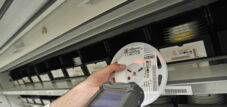[In collaboration with Kardex Remstar – ADVERTISING]
What are SMDs?
The term surface-mounted device (SMD) is a term from the electronics industry and refers to components that can be mounted on the surface. SMDs are extremely small and are the result of the ongoing miniaturization of electronic components. Unlike conventional components, SMDs are glued directly onto the surface of the circuit board and then soldered, rather than being plugged into it or wired to it. This eliminates the need for the complex drilling required on the circuit board for conventional components. The small size of SMDs has led to increasingly lighter and more cost-effective components for the electronics industry.
SMD components are typically transported in tapes wound onto reels after manufacturing. At the start of production, these reels are fed to the pick-and-place machines using trolleys called feeders. Larger SMD components are often packaged in plastic tubes or small pallets called trays. While trays can be inserted directly into the pick-and-place machines, feeders are also required for the tubes.
Afterwards, the circuit boards to be populated pass through various holding points one after the other, where the robot places the required SMD components onto the board and “glues” them in place.
The SMD components required for the production of electronic components are usually ordered, delivered, and stored in large quantities to ensure sufficient stock is available at the start of production. After production is complete, unused SMD components are...
- stored again
- prepared for the next production
- scrapped
For the flawless and efficient assembly of printed circuit boards with SMD components, the efficient picking of SMD reels from feeders plays a crucial role. The core objective is to make upstream and downstream processes, such as storing and retrieving SMD reels, supplying them to feeders, and returning excess material after assembly, productive and cost-effective. Rapid changeover of the SMD lines without loss of time or material is another key factor. To achieve this, the various storage and retrieval systems – such as carousel racks or vertical lifts – are equipped with application-specific software that controls the use of the SMD reels.
Customer requirements
The principle of intermediate storage of electronic components such as SMD components in the immediate vicinity of the assembly lines is becoming an increasingly important customer requirement. This results from an optimized material flow with ever shorter setup and downtimes and requires seamless traceability of the SMD components through the company's ERP systems.
When it comes to storing these parts, customers are looking for complete solutions that, in addition to providing the hardware (the rack storage), allow them to monitor and control the complex SMD production and give them the opportunity to subject the SMD stocks to a permanent inventory.
The software within the package plays a crucial role, recording the movement data of the stored goods and tracking the inventory and usage duration of the SMD components. The system also documents the allocation of materials to the respective production order. It identifies the availability of components for current orders and reserves the required quantities. Any shortages are immediately reported and reordered, or the components are requested again from the main warehouse.
In summary, the following customer requirements result:
- permanent inventory control
- Increased picking accuracy
- Storage of components according to requirements
- Reducing space requirements
- Optimizing access times
- Increased safety and ergonomics for staff in the workplace

